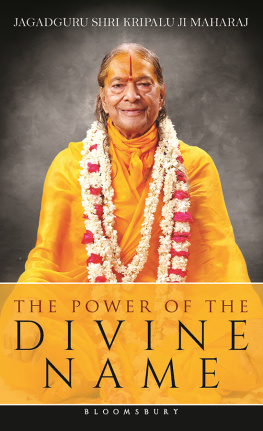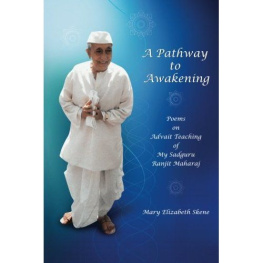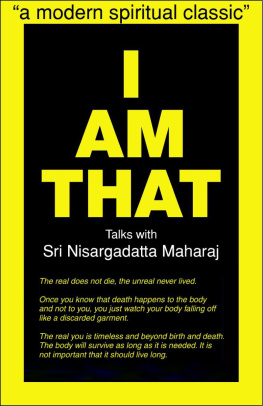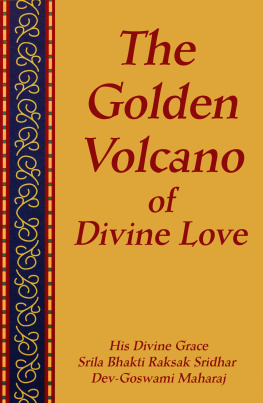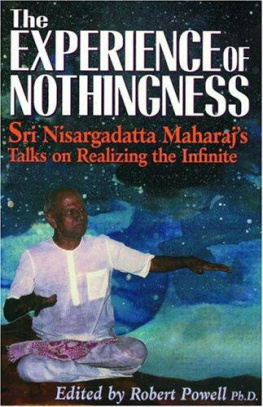Self-Love
Shri Nisargadatta Maharajs
Direct Pointers to Reality

Translated from the Marathi book Atmaprem by
Mohan Gaitonde
Original talks of Shri Nisargadatta Maharaj in Marathi compiled by
Shri Dinkar Kshirsagar

A Division of Maoli Media Private Limited
Self-Love
Shri Nisargadatta Maharajs
Direct Pointers to Reality
Translated from the Marathi book Atmaprem
published by Zen Publications in 2016
Credits for Atmaprem
Compiled by Shri Dinkar Kshirsagar
Edited by Shri Ravindra Katre
Copyright for English Translation of Atmaprem
2017 Jayashri M. Gaitonde
First Edition: November 2017
Published by
Zen Publications
A Division of Maoli Media Private Limited
60, Juhu Supreme Shopping Centre,
Gulmohar Cross Road No. 9,
JVPD Scheme, Juhu, Mumbai 400 049 India.
Tel: +91 9022208074
eMail:
Website: www.zenpublications.com
Cover & Book Design: Red Sky Designs, Mumbai
All rights reserved. No part of this book may be reproduced or transmitted in any form or by any means, electronic or mechanical, including photocopying, recording, or by any information storage and retrivel system without written permission from the author or his agents, except for the inclusion of brief quotations in a review.
CONTENTS


T he book you hold in your hands has had an interesting journey. And the journey is intrinsically linked with the advent of Sadguru Shri Nisargadatta Maharaj.
A sage named Shri Nisargadatta Maharaj of the Inchagiri sect of the Nath Sampradaya (sect) lived in the tenth lane of Mumbais Khetwadi locality. His presence was felt in the neighbourhood because of his regular bhajans morning, evening and night. Every Thursday and Sunday, in addition to the bhajans, Maharaj would also give a discourse. This discourse would be in the Marathi language (local language of Maharashtra and its capital city of Mumbai, where Maharaj lived).
Shri Dinkar Kshirsagar, an ardent disciple of Shri Nisargadatta Maharaj, was a regular at these bhajans and discourses, in the five-year period from 1977 to 1981. He would generally visit Maharaj in the evening, on Thursdays and Sundays as also on public holidays or on spiritually-significant days like Guru Pournima or Maharajs birthday. At the satsang, he would meticulously jot down Maharajs words and important instructions. His main objective in noting these meditations was to be able to ponder over them and allow them to seep deeper. These jottings ultimately spread over two large notebooks comprising over 500 handwritten pages. One day Dinkarji placed these notebooks at Maharajs feet seeking his approval. Maharaj took some time to go through them and to give his approval. He suggested that the material be made available to all those who were interested.
In 1987, that is about six years after Maharajs passing, Dinkar-ji remembered these notebooks and resolved to make the notes available to all. He divided the notes into 30 instalments and dispatched one instalment per month, without fail, to 300 Guru-bandhus (fellow disciples; literally Guru-brothers) over 30 months. Thanks to this seva (selfless service), Maharajs disciples had these priceless meditations delivered to their homes, free of cost.
The recipients were thrilled to receive the discourses and passed them along to other friends and seekers. Ultimately these notes were published in June 2011, in the original Marathi, by Shri Nitin Ram and Shri Ravindra Katre, both residents of Pune and keen devotees of Nisargadatta Maharaj. The book was named Atmaprem. They earned the eternal gratitude of Marathi readers for publishing, for the first time, Maharajs discourses during his last five years.
Nitin provides an interesting context to the contents of the book. Look at the way it happened. One relatively young disciple (Shri Dinkar Kshirsagar-ji) sat in front of Maharaj with a notebook. Every time something Maharaj said impacted him it could be a sentence or an entire chunk of conversation ... he jotted it down faithfullymaking note of the exact words used by Maharaj. Then he would wait till the next impactful segment. However he was clearly not a stenographer jotting down every single word spoken by Maharaj during satsang. So his notes reflect these somewhat disconnected, but important, observations by Maharaj. We felt that any effort to over-smoothen the text, or to provide connectives to the disjointed segments to make them cohesive, would be not only foolhardy but risky.
Later, with encouragement from Nitin and Ravindra, Atmaprem was published by Zen Publications.
However, before its re-publication Zen Publications gave a copy of Atmaprem to Shri Dinkar Kshirsagar for his review, in order to weed out possible editing or typographical errors and to incorporate any content updates that would make the text clearer. Dinkar-ji suggested the following:
Indicate the day and date of each discourse.
Add a brief note about the author, Shri Nisargadatta Maharaj.
Exclude Maharajs earlier discourses, covering the period from 1954 to 1956, from the scope of this book and instead publish them as a separate book.
All of his suggestions were incorporated into the revised version of Atmaprem. Also, as per his suggestion, the early discourses were published as a separate book, Sadguru Nisargadatta Maharaj Yanchi Durmil Nirupane.
Later, there arose a keen desire to translate and publish Atmaprem in English too. Both Nitin and Ravindra responded enthusiastically. Nitin urged Shri Mohan Gaitonde, who had been Maharajs translator for many years, to undertake the task. In response to Nitins gentle but persuasive coaxing Shri Mohan Gaitonde-ji finally agreed to translate Maharajs discourses, published in Atmaprem, into English. The result of that intimate satsang, between Maharajs words and Gaitonde-jis contemplation of them, is the book you hold in hand Self-Love.


W hen Shri Nitin Ram urged me to translate Atmaprem, comprising Maharajs discourses in Marathi language, I was reluctant to accept the difficult task. But Nitin insisted, so I got down to the task. I remembered Maharajs words, You are never the doer. Things happen and you just become instrumental to the happening of these events.
Soon after starting the work, its nature changed from a mere task to Satsang, which means being in the company of Maharaj. It was my experience of being at the feet of the Sadguru, without leaving my home and going anywhere.
After reading various books of Maharajs discourses published in Marathi so far, I find these discourses, written down by our Guru-bandhu Shri Dinkar Keshav Kshirsagar, to be the best. I was present when most of these discourses were delivered by Maharaj. My seat used to be adjacent to that of Dinkar. Our Guru did not appreciate taking notes during His talks, as He demanded total attention, without which transformation of the listener was impossible. I took no notes. But undisturbed attention to Maharajs words was not possible for me due to my thoughts, even though I did not write even a single word uttered by Him. Hence, I cannot congratulate myself for strictly following Maharajs instructions, as Dinkars contribution was anyhow better than mine.
Next page

